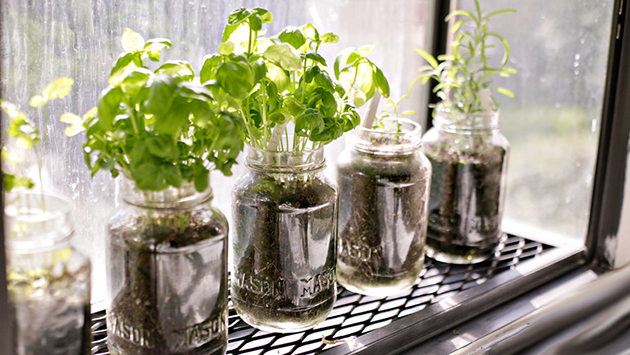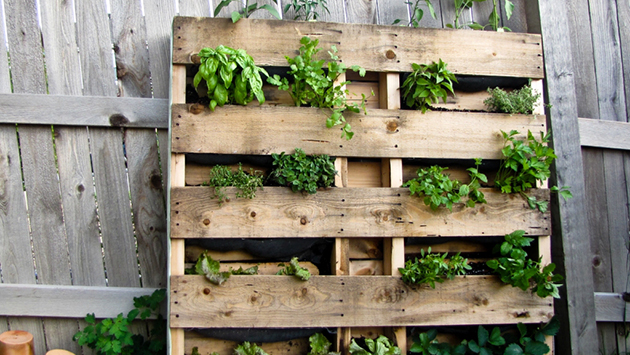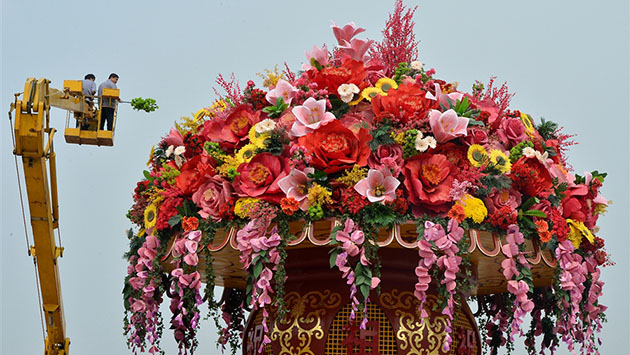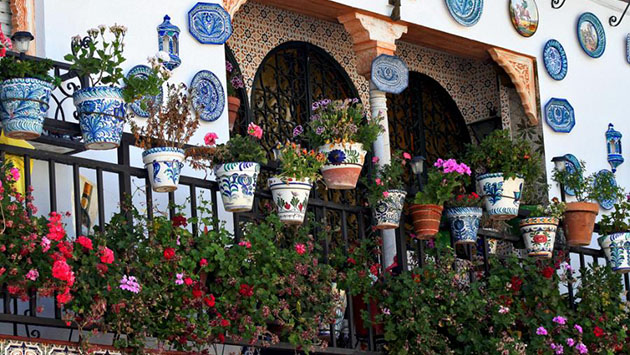A common misconception about gardening is that it requires a big backyard and a lot of money. That’s why a lot of people, namely city dwellers on a tight budget, shy away from growing their own food. If you’re one of them, we have good news for you:
You can certainly grow your own food with a teeny-tiny balcony (or indoor space near a window) and only a few dollars in your bank account!
How?
Containers. All you need is a bunch of containers. It’s entirely possible to grow all kinds of herbs, fruits, and vegetables in all kinds of large and small pots, window boxes, hanging baskets, or used rain boots.
Yes, used rain boots. You don’t need a typical pot; you can use pretty much anything as a container!
Affordable upcycled container ideas
There’s no need to drop $25 on a fancy ceramic pot when you can dig around your garage or a thrift store. There are so many different things you can upcycle into a container for your balcony or window garden. Here are some fun, practical, and ridiculously cheap ideas:
Mason jars

Mason jars are a very versatile type of container for herbs. You can place them indoors by a window, hang them from a window sill, put them on an outdoor table top, adorn them on a balcony railing, or set them on the ground. You just have to make sure they’re in direct sunlight for the most part of the day.
If you don’t have any Mason jars (or empty pasta sauce jars) lying around your house, you can look for some at a thrift store or, as a last resort, buy a dozen of brand-new Mason jars for under $20 at Walmart, King Soopers, Safeway, or Amazon.
Pallets

Pallets are a great container for herbs, lettuce, or strawberries because they let you save a lot of space and money! You can pick up some good pallets behind a department store, grocery store, or pretty much any type of business that orders a lot of inventory on a regular basis. Be sure to check with the manager or owner first; they’d be likely to let you haul away the pallets for free just so they won’t have to pay a company to do it. You can also check Craigslist for free pallets.
Once you get your hands on a pallet, you have to make sure it’s not made of pressure-treated lumber. You don’t want toxic chemicals to leach into the soil and ruin your plants. Look at the cut end of the pallet. If there’s a green tinge, then it’s probably pressure-treated. If there’s no green tinge, you still have to make sure it’s definitely not pressure-treated. It’s better to be safe than sorry, after all! So go ahead and cut a small piece of the pallet. If the inside is yellow or white, then it’s probably not pressure-treated. For further information, check out Instructables.com’s How to determine if a wood pallet is safe for use. If you find that the pallet hasn’t been pressure-treated, sand it down and get it ready to serve as a gardening container! Growing a Greener World has a great set of instructions on how to do it right.
Tin or plastic buckets

You can use paint cans, empty coffee cans, sand buckets, or anything else you can find at the dollar store or around your house. You just have to remember to punch drainage holes in the bottom of each bucket.
Things to consider before getting a container
Before you let your imagination go wild and repurpose something into a container, take a look at the following list of important things to consider. It’ll help you choose the best container for the type of plant you want to grow.
* Size: When it comes to growing herbs, fruits, or vegetables, bigger is always better. The larger the container, the more likely the crop will come out all right. If the container’s too small, your crop will become root-bound and die. Note that most vegetables require a container that’s larger than 5 gallons.

* Weight: If you choose to use a tall container, you have to make sure it has enough weight in the bottom so it won’t fall over. If you intend to move the container around frequently, it’d be best to go with a lightweight container made from synthetic materials (such as a sand bucket or a plastic drum).
* Material: While most materials are safe to use, it’d still be wise to choose one that would suit your needs the best. Here’s a list of acceptable materials to use and how each one will benefit you.
– Plastic: With plastic, soil will not dry out as quickly as with other materials. Also, plastic containers are easy to move around, even after you plant in them.
– Ceramic: Ceramic pots are usually frost-resistant and will last for years. They also look nice and will pretty up your balcony. However, ceramic pots will make soil dry out quickly, so it’d be wise to line them with plastic sheets. You might be able to score a few ceramic pots for pennies on the dollar at a thrift store.
– Stone/concrete: If you’re worried about someone stealing your plants, you should invest in a stone or concrete pot. Those bad boys are extremely heavy, highly durable, and frost resistant.
– Untreated wood: This is a highly versatile material, because it can contain any type of plant. However, soil will dry out quickly, so be sure to line the inner walls of a wooden container with a plastic sheet, or just water the plant often.
– Metal: While this is an acceptable material to use in a container, it doesn’t do so well in extreme weather. Metal containers heat up quickly in hot weather and fail to provide adequate insulation in cold weather. If you must use metal containers in extreme weather, line them with plastic sheets or bubble wrap or just bring the containers inside when the weather gets too bad. Otherwise, only use metal containers in areas where the climate is generally mild.
– Fiberglass: This inexpensive material is ideal for balconies because it’s lightweight and can be moved around a lot. Also, fiberglass containers are weatherproof, but they don’t last a long time because they’re fragile.
Designing your balcony garden

Before starting your balcony garden, ask yourself the following questions to determine which fruits, vegetables, or herbs would fare best on your balcony:
* What type of microclimate exists on your balcony? Is your balcony exposed to wind, cold, and sometimes frost?
* What direction does your balcony face? If your balcony faces west, your plants will get plenty of sun in the afternoon and evening, and they’ll be shielded from the northeast winds. Plants in east-facing balconies are often subjected to frost and the abrupt change in temperature due to the sunrise in the morning. North and south facing balconies get sunlight for the most part of the day, and north-facing balconies get some wind.
* Is your balcony sheltered from the wind? Is there a screen or a wall that can protect your plants from the wind?
Take those questions into consideration and determine the best types of fruits, vegetables, herbs, or other plants for you to grow on your balcony.
Next, grab a sketchbook and plan different options. Be sure to get the measurements right. Figure out which types of containers would fit in your space in the best way possible.
Once you have everything planned out, get the containers you need, start planting, and watch your balcony garden flourish in no time!
